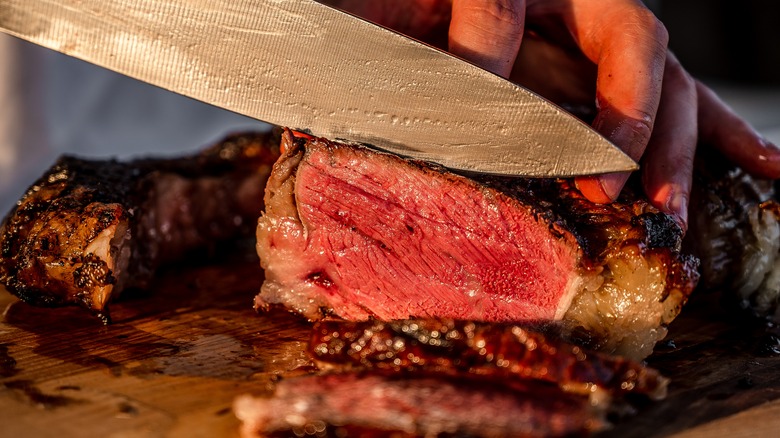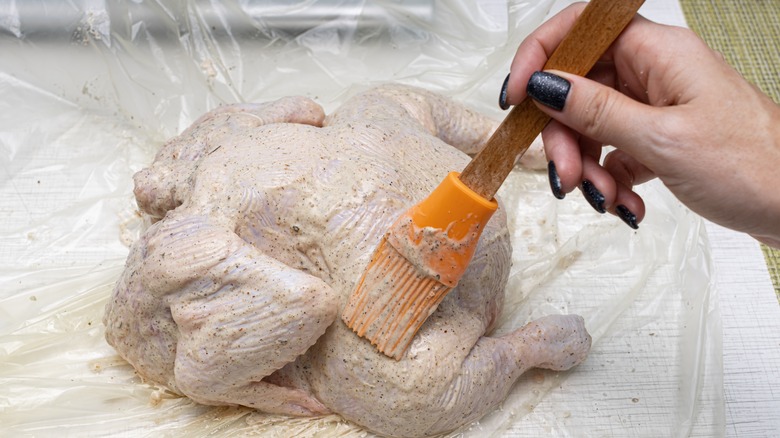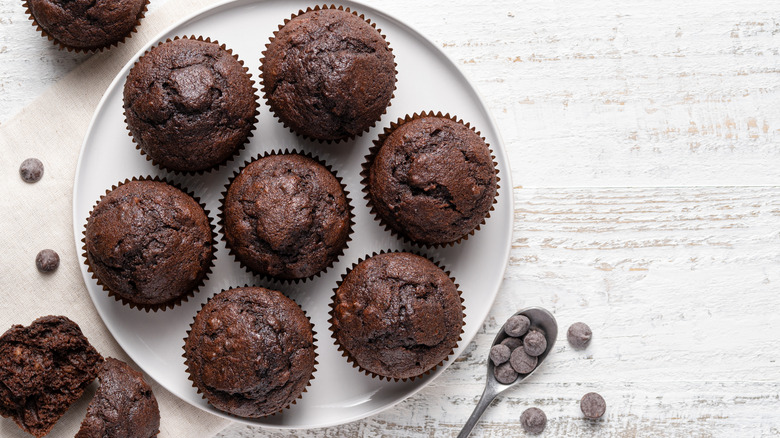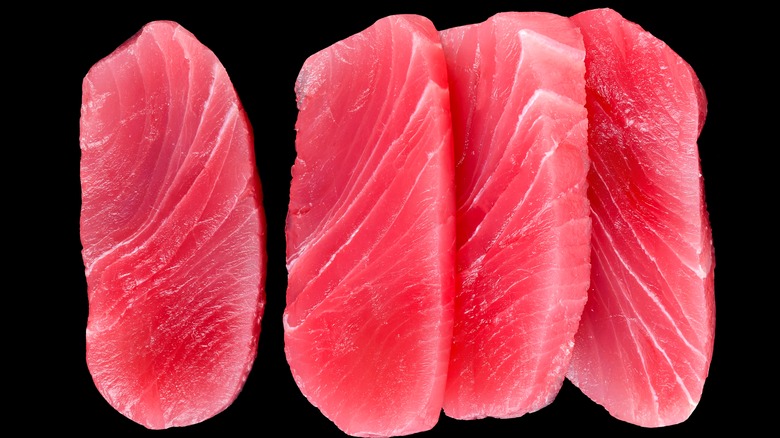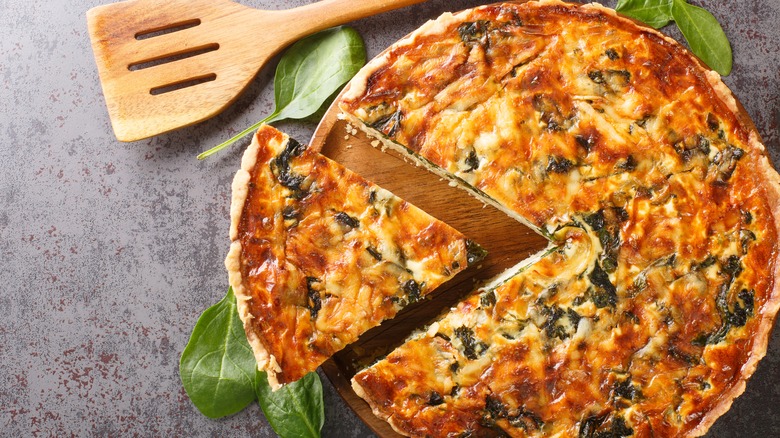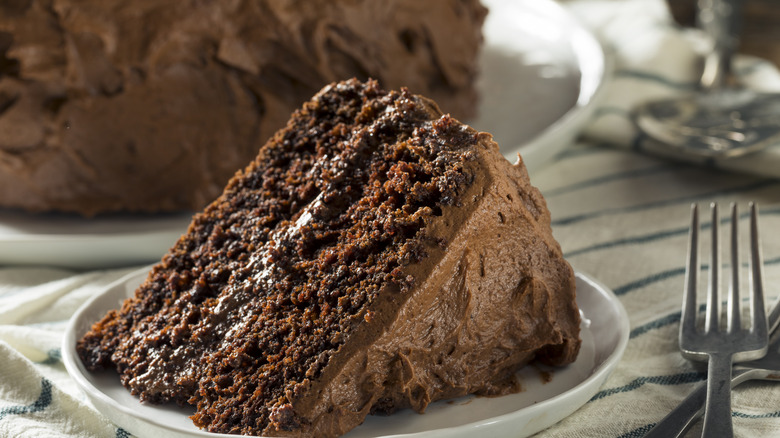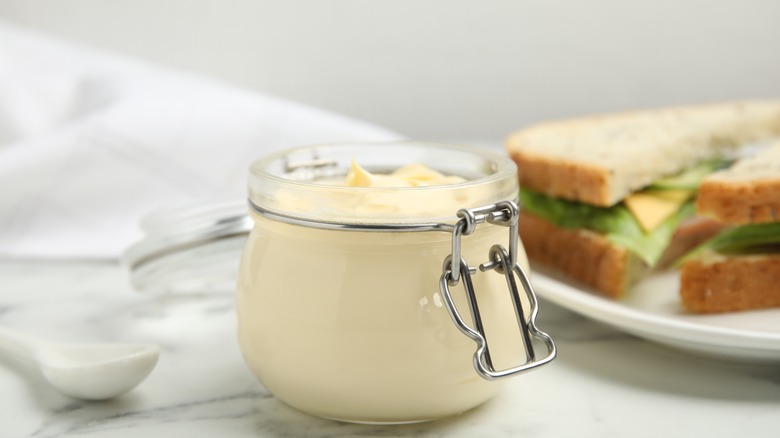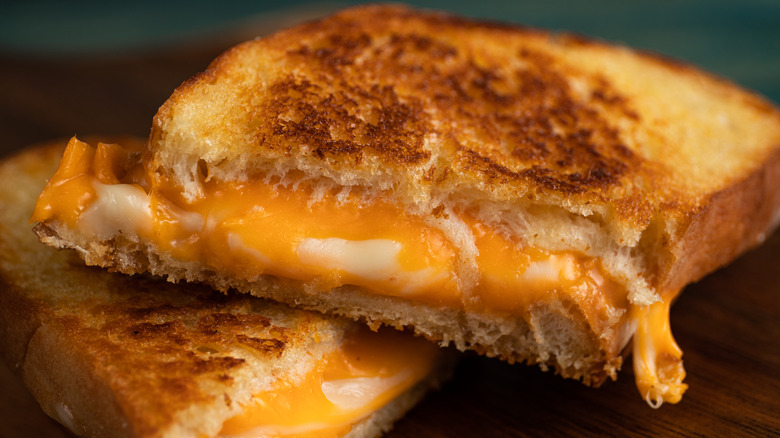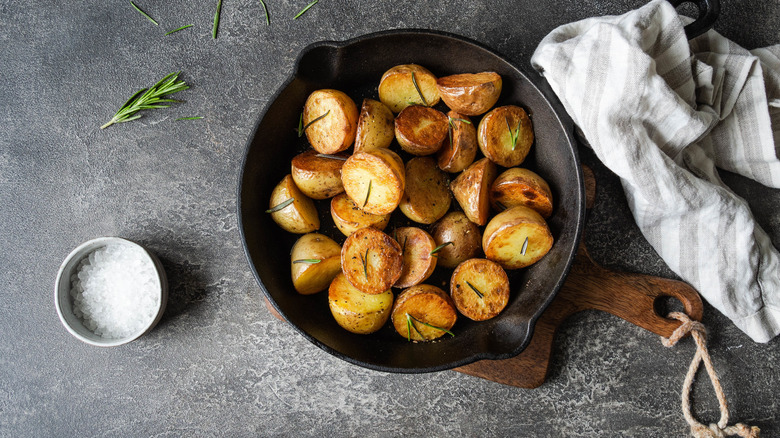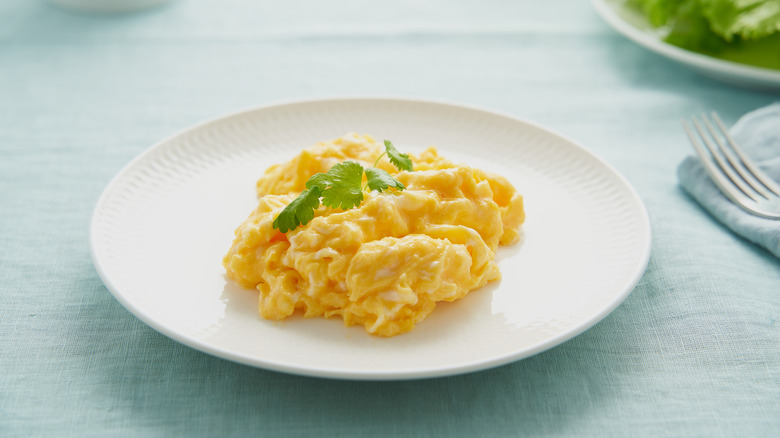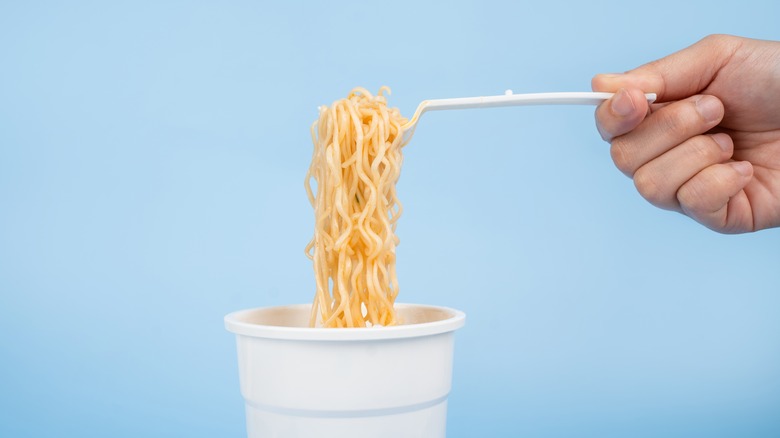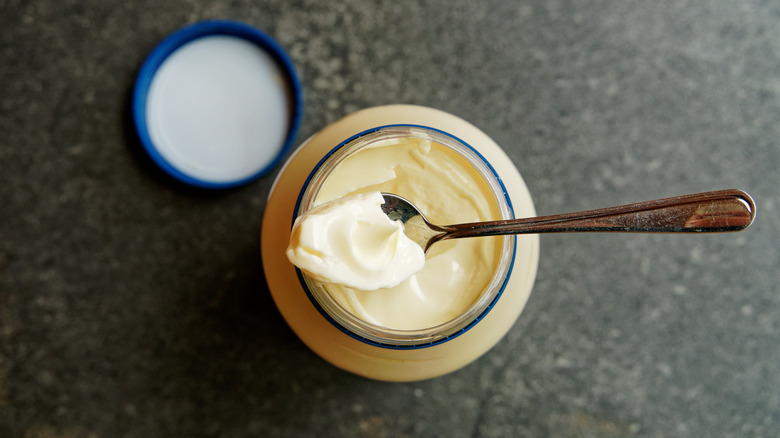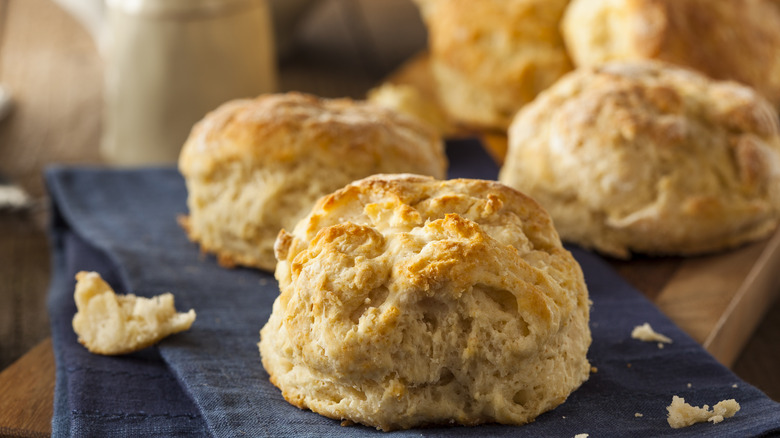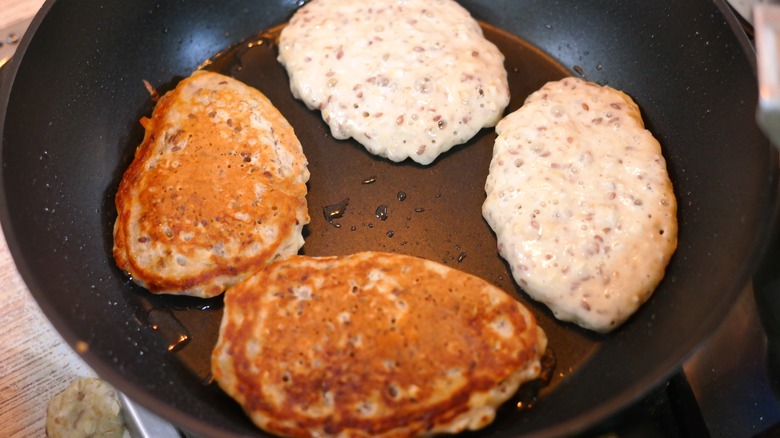15 Tips You Need When Cooking With Mayonnaise
What's your favorite condiment? Our research indicates that mayonnaise is one of the top contenders — placing third in a survey of condiment preference — behind the favorite ketchup and runner-up hot sauce. But what exactly is mayonnaise, and why do some people have a strange obsession with it?
Mayonnaise is made from a few simple ingredients, although industrialized mayonnaise production (think Hellman's and Kraft) include added stabilizers in the recipes. Most homemade classic mayonnaise recipes include egg yolks, neutral oil, and an acid like lemon juice or vinegar. Combining these ingredients gives the mayonnaise a mildly tangy taste with an unctuous, smooth texture.
But mayonnaise is more than just a condiment for you to spread on your favorite straight-off-the-grill burger in the summer. Its chemical properties and composition make mayonnaise an excellent ingredient to always have on hand in the kitchen, whether baking, cooking, or mixing a sauce. So here are some of the most important things you need to know when working with this miracle ingredient.
Use it to tenderize meat
Mayonnaise and meat aren't a combination that is too far off. But, you're likely only adding mayonnaise to your meat after it's done cooking.
Mayonnaise is an ingredient that will change how you cook meat forever because it has numerous tenderizing properties. Adding mayonnaise to your marinade ingredients can help soften up tough meat and infuse a lot of flavors. This is because mayonnaise is comprised of fats — which easily penetrate the meat and take herbs and spices with it. Outside of marinating, mayonnaise is also used to create a crust on the outside of the steak. The proteins and the fat in the mayonnaise work together to more readily form a brown crust that all grillers desire. This important grilling step, called the Maillard reaction, produces a steak that is crispy on the outside and soft and tender on the inside. In addition, the fat in the mayonnaise can help create a protective barrier that stops the steak from sticking to the grill. So there's no reason not to use mayonnaise when you're grilling.
Keep your chicken moist with a slather of mayo
Mayonnaise has applications outside of red meat, too. It's the condiment that will make your baked chicken ultra-moist. When the eggs and the oil are emulsified together, it creates a moisture barrier. When you spread it all over your raw chicken before baking, you'll find it keeps the moisture in the meat — resulting in a juicier bird. Like with steak, using mayonnaise on the outside of the chicken also promotes a browner crust (because who doesn't love crispy chicken skin) through the Maillard reaction. Your bird will come out evenly browned if you take the extra step of coating the bird before placing it on your rack.
You can use this trick if you're grilling chicken or roasting it in the oven. We recommend pairing the mayo with other bright flavors, like an additional squeeze of lemon juice, garlic powder, and aromatic herbs, to help boost the taste of your poultry.
Make a tender batch of muffins using scoop of mayo
Mayonnaise in muffins? You might be scratching your head at this kitchen hack, but it becomes more logical when you think about mayonnaise more as a sum of its parts rather than the condiment you slather on a burger. You usually add eggs, acid, and oil to your muffins anyway, so why not amp up your muffins with this quick hack?
Dry muffins are the bane of any baker's existence. You may have over-mixed your batter, left them in your oven too long, or messed up your ratio of dry to wet ingredients entirely. Regardless of the cause, your muffins come out of the oven bready and cloggy rather than plush. The secret to alleviating some of your muffin woes is to substitute mayonnaise into your recipe; you'll want to use 3 tablespoons of mayo for each egg your recipe calls for.
Help your tuna achieve grilling perfection
Mayonnaise and fish are a little bit more of an odd combination than other proteins. But you should still consider using mayo to grill tuna. The primary use for this condiment in grilling these delicious fish steaks is to prevent the flesh from sticking to the grill. Many home grillers coat their fish in copious amounts of oil to prevent sticking before slapping it on the rack. But since mayonnaise contains a fair amount of fat (and adheres to the fish much more effectively than oil), it is a much more suitable solution. The emulsion is also effective in locking in moisture, which is easily lost when grilling a flavorful, fleshy fish like tuna.
Doesn't mayonnaise have a strange aftertaste that will leave your fish tasting more like a fish salad than a tuna steak? Fear not, the cooking process will leave your steak without a distinguishable mayonnaise flavor.
Prevent mayo from splitting with a splash of wine
Making homemade mayonnaise is a feat in itself. But, some minor hiccups along the way can alter the final taste and texture of your condiment. One of these phenomena is splitting. Splitting occurs when oil and water do not blend well with one another. This can be caused by a multitude of factors, including using old eggs and not matching up the temperatures of your ingredients just right. If you notice your homemade mayonnaise has split, don't panic — there's a simple way to help fix it.
You can use white wine to help fix separated mayonnaise. White wine contains lees — leftover yeast particles from fermentation — that can easily foam and emulsify with the ingredients in your mayonnaise. The resveratrol in white wine also lends a helping hand; this compound is lipophilic, meaning it is attracted to fats. To use this trick, add a couple of tablespoons of white wine to some of the broken mayonnaise before mixing the new solution back into the rest of the mayonnaise.
Use mayo as the secret ingredient for homemade quiche
Quiche is one of the ultimate simple breakfast foods you can make. This savory egg pie contains your favorite vegetables and savory egg accompaniments, including fresh herbs, cheeses, and leafy greens. And although you have to have a little bit of something special in your quiche — like a quiche Lorraine with bacon, French cheese, and heavy cream — you also need to clue yourself into ingredients that impact the fundamental structure of the breakfast (or lunch) meal.
You'll want to try adding mayo to your homemade quiche for extra flavor and texture. However, unlike other recipes, you shouldn't use the mayonnaise to replace the eggs (it is an egg pie, after all, not a mayonnaise pie). Instead, add a few tablespoons to your mixture of eggs, milk (or cream), and vegetable ingredients and bake as usual. You'll find that your quiche has a much more pronounced flavor and buttery texture.
It can help keep your cake recipe soft
Let them eat cake. Every home baker should have a good cake recipe in their baking arsenal. Of course, all cakes should be moist when they come out of the oven — whether it's fudgy chocolate, decadent red velvet, or sweet yellow cake. But any baker will tell you that nailing down this particular texture is complex and can be easily disrupted by the ratio of ingredients in your recipe or some minor technical errors. And if you're baking for a special occasion, we doubt you have time to do a re-do.
One way to help alleviate your textural woes is to add mayonnaise to your cake. This trick works exceptionally well for dense chocolate cakes because the oil in the mayonnaise helps keep the batter soft and helps amplify the chocolate flavor. You can play around with your ratio of ingredients in a homemade cake or use the mayonnaise to replace the oil in a boxed cake mix.
Be patient when making homemade mayo
Most people pick up a jar of mayonnaise between grocery store runs. But, taking the extra step to make your homemade mayonnaise allows for creative license and the opportunity to infuse more flavors into your condiment — which we think makes it worth a couple of extra steps.
To make homemade mayo, you're going to need to combine a light neutral oil (like vegetable or canola oil) with your eggs. The reason your blender mayo may not turn out smooth, though, is that your ingredients are not all at the same temperature. You should also be sure to add your oil to the eggs slowly. Pouring the oil in too fast prevents emulsification from developing and will cause the mayonnaise to come out oily. Instead, the proper method is to start with tiny drops of oil, then gradually add more as the mixture thickens. If you're patient, you'll be rewarded with a delicious, sandwich-worthy spread.
Substitute mayo for butter for a delicious grilled cheese
If you're anything like us, you think a little too much about grilled cheese. Your bread, cheese selection, and any additional toppings you plan to add to your unique sandwich play a role in your eating experience. But you may not think about how your spread impacts your grilled cheese. So we tested butter and mayo to determine which spread makes a better grilled cheese — and the results are promising.
Mayonnaise is much easier to spread out of the container than butter, and it also has a comparatively higher smoke point than butter; you won't get those unsavory bitter notes and burning before the sandwich is adequately cooked. Our test revealed that the sandwich cooked in mayonnaise had even more browning, which in turn yielded a crunchier sandwich. Try this hack with full-fat mayonnaise the next time you're craving grilled cheese.
It can elevate your roasted potatoes
If you're mixing mayonnaise and potatoes, it's likely as a side for dipping your fries into. But another type of potato cooking technique that can really benefit from the help of this condiment is roasted potatoes.
You should slather your potatoes in mayo before roasting them because it will dramatically improve their flavor and texture. This tip was initially suggested by TikTok foodie Eitan Bernath, who shared the hack in one of his videos. He slathers the fingerling potatoes in a thick coating of mayo with paprika, garlic powder, onion powder, salt, cracked pepper, and a burst of freshness from chopped parsley. Then, he transfers the potatoes to a metal baking sheet and bakes for 20 to 25 minutes. The creator notes that these potatoes come out "pillowy on the inside" and "crunchy on the outside," which is the ideal texture for any roasted potatoes in our book.
Make your scrambled eggs better with mayonnaise
We might think you're a little suspicious if you eat scrambled eggs with ketchup — but what does it say about you if you add a bit of mayo to your breakfast routine? Scrambled eggs are one food that benefits a lot from the fattiness of this spreadable condiment. Adding mayonnaise will change your scrambled eggs forever because the oil will make the eggs much more smooth and creamy. Plus, you're just adding eggs back into an egg dish. And if you're a mayo-hater, fear not. You won't be able to taste much of this condiment after your eggs are finished cooking.
You'll only need a tablespoon of mayonnaise for every two eggs you cook. Mix the mayonnaise into the eggs with any seasonings before adding them to the pan. Cook the eggs in a skillet with a bit of butter (because who doesn't love the flavor of melted butter and eggs), and serve your soft scrambled on toast, in a wrap, or as-is.
Use mayonnaise in your instant ramen for more flavor
Instant ramen... and mayonnaise? We're scratching our heads a little bit over this one.
Like other food trends, you can thank TikTok for this one — specifically creator @EatWithAdrian. In one of his videos, Adrian combines instant noodles, minced garlic, Kewpie mayo, and an egg to make an upgraded instant ramen dish. First, he cooks the instant noodles in a pot of water and combines the mayo, minced garlic, egg, and seasoning packet together. He then adds some of the noodle water to make the sauce a bit thinner before adding the noodles and enjoying.
The key to this TikTok instant ramen hack is to use Japanese Kewpie mayo rather than plain mayonnaise. There are some differences between Kewpie and regular mayo. Kewpie uses egg yolks only (rather than the whole egg in regular mayonnaise), a blend of vinegar, and umami-packed MSG. These ingredients give Kewpie mayo a more robust flavor than your traditional grocery store variety.
You don't need to refrigerate mayo
We can safely venture to say that most people store their mayonnaise in the fridge after opening. After all, you've always been told not to leave tuna salad sitting in the sun for too long, right? But did you know you can actually store an open jar of mayonnaise in the pantry?
The main reason why you can store mayonnaise in the refrigerator is because it contains a high level of acidity. Acid makes spaces inhospitable to some pathogens, meaning your mayonnaise will be safe even if you store it in a pantry. It is only safe to keep mayonnaise outside the refrigerator if made from pasteurized eggs. Homemade mayonnaise should also be stored in the fridge because it doesn't have the same stabilizers and additives as commercially produced brands like Hellman's or Kraft. To maximize its shelf life, keeping commercially-made mayonnaise in the refrigerator might also be a good idea. Refrigeration can make mayonnaise last two months longer, maintain flavor and color, and prevent pathogen exposure via cross-contamination with dirty utensils.
Add it to homemade biscuits
It's hard to say no to biscuits and gravy. And the only thing that will improve your plate is to make the biscuits yourself. Of course, everyone knows about the importance of adding buttermilk and grated butter to homemade biscuits, but what about mayonnaise? It is the secret ingredient that will change your biscuits forever.
The best part about using mayonnaise for a biscuit recipe is that you can use it to replace other ingredients. Combine self-rising flour (including leavening agents), milk, and mayonnaise to make your base biscuit dough. These biscuits are significantly more straightforward to prep and shape than standard cut biscuits; you can scoop and drop them onto the baking sheet and bake away. Not only does the mayonnaise provide a lot of moisture to the dough, but the acidity of the condiment will help keep the biscuit tender during the baking process.
Add it to your batter for fluffy pancakes
Don't forget to add pancakes to your list of the best breakfast foods ever. You can customize your short stack with a range of toppings like fresh blueberries, decadent chocolate chips, or our all-time favorite: maple syrup. But, no topping can fix a fundamentally flawed pancake batter.
One of the pitfalls of making pancakes is that the batter always comes out dry. This might result from improperly preparing your batter, over-mixing, or, most often, not adding enough moisture to keep your pancakes soft. Mayonnaise is a surprising ingredient that will help you get fluffier pancakes for several reasons. The acidity interacts with the baking soda or baking powder to help produce a better rise. Meanwhile, the proteins in the egg whites can trap these air bubbles, while the fats in the egg yolk and oil can help slow the gluten from setting in the batter. You'll only need to add 2 to 3 tablespoons of mayonnaise to your pancake batter for a fluffy, plush result.
Static Media owns and operates Tasting Table and Mashed.

